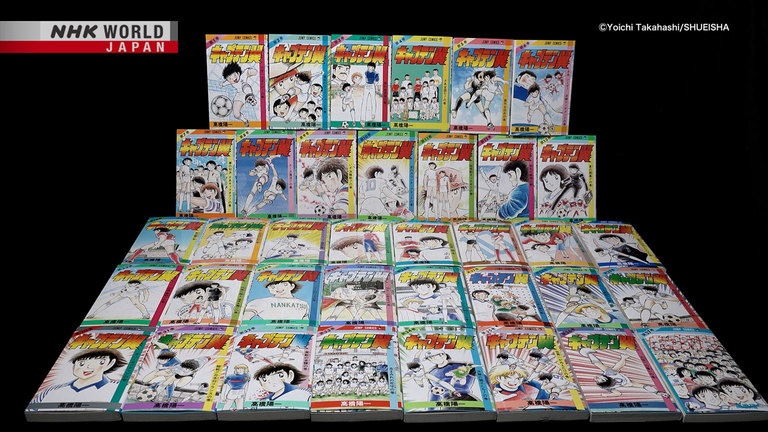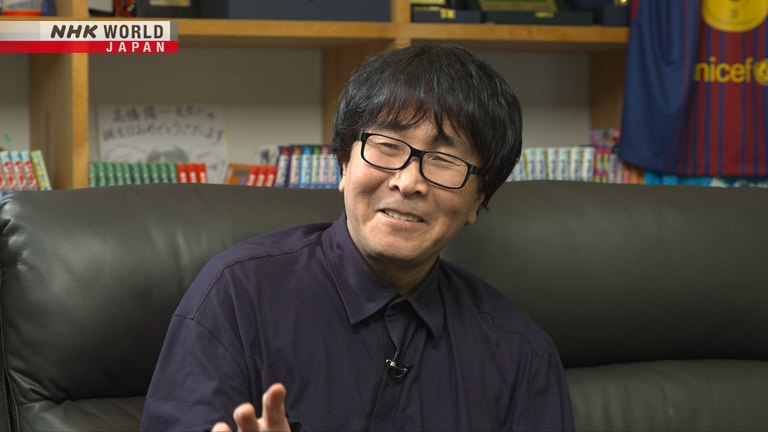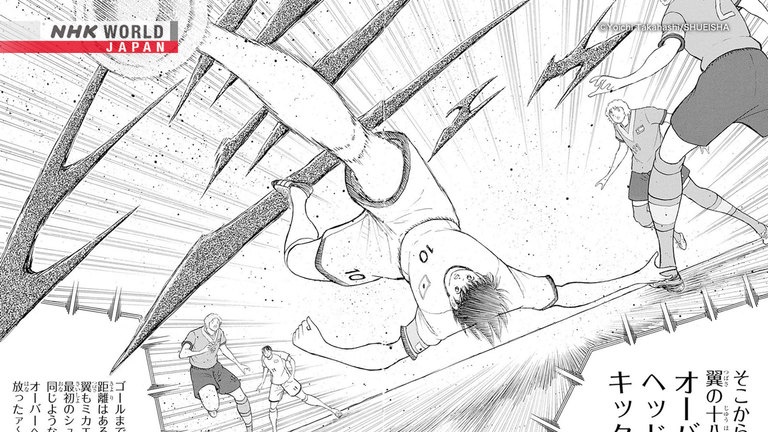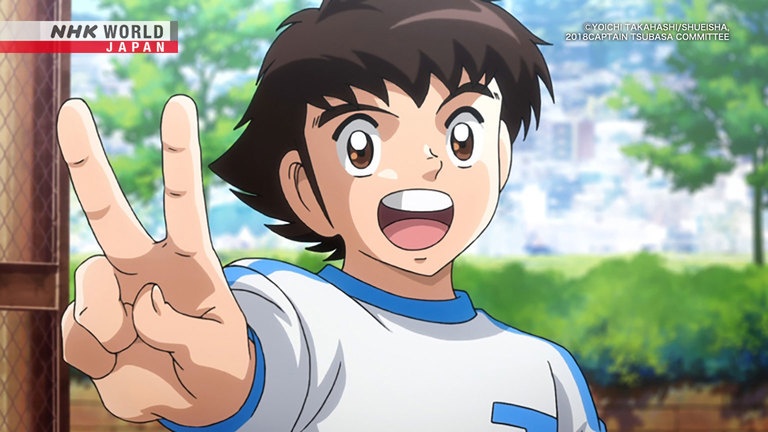Captain Tsubasa Special
ANIME MANGA EXPLOSION is a new series that dives into the world of Japanese anime and manga, both of which have gained an immense global following. This time, we're featuring Captain Tsubasa, the timeless soccer manga from Takahashi Yoichi. The series has sold over 90 million copies worldwide, and the hit anime has been broadcast in more than 50 countries. We sit down with Takahashi Yoichi for a lengthy interview to unravel the series' secrets and discover why it has become so beloved across the globe. We also find out how the exciting super shots in the anime are created.




Transcript
ANIME MANGA EXPLOSION.
A certain manga is beloved by soccer superstars worldwide.
Andrés Iniesta, a former Spain national team member who has played in Japan, is one of them.
Multiple factors influenced
my decision to come to Japan,
but playing in the birthplace
of "Captain Tsubasa" is a great honor.
When Messi joined FC Barcelona, he said this:
I'm on the same team as Tsubasa!
As you may have guessed, that manga is "Captain Tsubasa."
The creator of the manga is Takahashi Yoichi.
International superstars watch with child-like wonder as he draws in front of them.
How has "Captain Tsubasa" captivated fans worldwide?
And how did Takahashi Yoichi discover his creative secrets?
My inquisitive mind always wants
to create new, cool things.
The TV anime has also been a driving force behind "Captain Tsubasa's" global appeal.
How does the anime bring the exciting action from the manga to life?
Let's take a deep dive into the world of "Captain Tsubasa."
"Captain Tsubasa" began its serialized run for a weekly manga magazine in 1981.
The main character is soccer prodigy Ozora Tsubasa, whose motto is "The ball is our friend."
The story follows Tsubasa's incredible journey,
from meeting his future teammate Wakabayshi Genzo to defeating numerous rivals and eventually reaching the world stage.
The hit TV anime solidified the series' immense popularity two years after the manga began.
"Captain Tsubasa" is Takahashi's debut manga.
This is an original drawing from episode one which Takahashi still holds onto dearly.
Rough edges from an inexperienced 20-year-old remain.
While working as an assistant, the young artist brought drafts of his soccer-themed manga to an editor.
I fell in love with soccer in high school
after watching the 1978
World Cup Argentina on TV.
I soon realized the sport
was famous worldwide.
At the time, Japan loved baseball,
so there were a lot of baseball manga.
I thought there should be other sports manga.
When the series began in 1980, Japan had no professional soccer league, and baseball was the most popular sport.
Most sports manga were based on baseball. Still, Takahashi chose to focus on soccer.
I eventually realized how important it was
to show the exciting parts of soccer.
Things like amazing shots
and how plays form on the field.
How was Takahashi able to capture the appeal of soccer?
You can find hints of the artist's ingenuity in his original drawings.
Take a look at this page.
Takahashi adds dynamism using a certain technique.
I wanted to give Misaki and Tsubasa's pass
a three-dimensional feel.
I wanted to express the rhythm.
Movement and action play large roles
in any sports manga.
In my pursuit of dynamic action,
I started drawing across panel borders.
Panels refer to the boxes found on a manga page.
They separate scenes in the story and are read from top to bottom and right to left in Japan.
However, Takahashi ignored such rules and drew action that expanded outside the panels.
For this scene of Tsubasa performing a super shot, he split the two-page spread into top and bottom.
And here, he uses both vertical and horizontal splits.
But Takahashi didn't stop there.
He used another technique to help capture the action of soccer.
This is a scene with Tsubasa lining up a shot.
So many things happen at once.
There is movement all over the field,
and I try to portray that on the page.
Takahashi used a two-page spread to portray the momentary drama of a single play.
The image depicts the action from four different perspectives.
The upper left of the page shows a bird's eye view of the game.
The upper right is an action shot behind Tsubasa from the opposing goalkeeper's view.
The lower part is a view of Tsubasa from the front.
And to the left, a teammate cheering from the bench.
The play-by-play announcer creates tension in the speech bubble:
"Tsubasa has rotated his body and is getting ready to shoot!"
With this layout, readers should
get excited about what's next.
Will he shoot?
What will the defenders do?
Excitement spurs the readers' curiosity
and keeps them turning the pages.
The bold layout lets Takahashi assemble a multi-perspective image that heightens the anticipation.
"GOAAAAAAL!"
Takahashi has continued to pursue new ways to express soccer.
I want the shooting forms
of Tsubasa and Hyuga to look cool.
That's always on my mind as I draw.
What kind of poses would look best?
How cool can I make it?
My inquisitive mind always wants
to create new, cool things.
Takahashi's inquisitive mind takes shape in this panel.
I love drawing horizons.
I wanted to keep stretching this out.
I angled the image
so it looks up from the ground.
This changes how distance feels
in front and back.
The panel is composed from an extremely low angle, with Tsubasa kicking the ball toward the reader.
Takahashi even drew the bottom side of the players' boots.
I imagined how it would look
if I were inside the ground.
And how it would feel
if the athletes were right next to me.
It's about creating
the feeling of being on the field.
This would be impossible for a TV camera,
but it's easy with manga.
Although "Captain Tsubasa" is now a beloved hit, it was in danger of being canceled early on during its serialization.
It was featured in one of the most prominent manga magazines of the time.
The magazine had a rule that if a series' popularity didn't rank high in reader polls, it would be canceled by week ten.
After episode three, "Captain Tsubasa" ranked in at number 12.
The series was in danger.
The first three episodes fell lower and lower.
I knew I needed to change something.
I had to figure out
how to leave a mark with episode four.
I discussed it with my editor.
For episode four, Takahashi decided to go with -
- the overhead kick, Tsubasa's specialty!
I had seen footage of Pelé
doing overhead kicks.
It was such a beautiful shot.
If that didn't work, nothing would.
I took a "So what?" attitude.
The episode left a positive impact on readers, moving the series up to number four on the rankings.
"Captain Tsubasa" had survived.
The editorial department told me the series
would be able to continue beyond ten weeks.
I was so happy to finally slow down.
I could take my time with Tsubasa's rivals
and prepare for matches.
Takahashi came up with a number of super shots for the manga's unique characters.
Here's a scene of golden combination Tsubasa and Misaki kicking the ball at the same time.
Takahashi named it the "Twin Shoot."
I thought two would be
more powerful than one.
That's not the case in reality,
but I thought I could make it work.
The world youth arc features the "Reactive Fast Kick Quick Gun" shot.
This super shot by Chinese player Xiao Junguang returns the ball at twice the power.
Another fan-favorite shot is the Tachibana brothers' "Skylab Hurricane."
The fantastical super shot features one player on the ground launching the other high up in the air.
I'm a fan of pro wrestling
and all the different move combinations.
I thought it would be fun
to add some of that to soccer.
Takahashi continued to excite readers with imaginative super shots that would become synonymous with the characters.
Even during real matches, fans comment on crazy shots with things like, "Real-life Captain Tsubasa!"
Nine years ago, a video from these pro soccer players went viral.
Reactive Fast Kick Quick Gun!
That was it, right?
There are now more than 100 volumes of standalone "Captain Tsubasa" manga.
Available in 20 languages, including English, French, and Italian, there are more than 90 million copies in circulation.
Takahashi's manga has influenced athletes not only in Japan but around the world.
This is Iniesta's uniform.
He told me he was a big fan of the anime.
And this is from Fernando Torres.
A personal message from former Spanish national team member Fernando Torres.
It's incredible to think so many players
grew up with "Captain Tsubasa."
How has "Captain Tsubasa" been able to reach the hearts of so many people around the world?
Nakano Haruyuki, a manga critic specializing in 1980s manga culture,
says that Takahashi added new charm to the sports genre.
Before "Captain Tsubasa,"
sports manga always focused on tenacity.
But "Captain Tsubasa's" focus was on fun.
That separated it from the others.
Back then, the sports world was harsh.
It wasn't easy to become skilled.
But somehow this manga
makes the sport feel approachable.
Readers love recreating shots in the manga.
For me, that is what makes it special.
The manga impacted the Japanese soccer world.
Nonomura Yoshikazu is a former professional soccer player
and currently serves as the sixth chairman of Japan's professional football league.
He discovered "Captain Tsubasa" in third grade.
"The ball is our friend."
I would even sleep with the soccer ball.
Every morning, I would put on soccer boots
and kick the ball to school.
I know that a lot of kids
were impacted by "Captain Tsubasa."
This shows the change in children 12 and under who play soccer.
Before "Captain Tsubasa," around 120,000 were registered with the Japan Football Association.
After its serialization ended in 1988, the number doubled to around 250,000.
Skill level increased a lot in ten years.
"Captain Tsubasa" influenced soccer players
and helped newcomers discover the sport.
More kids participating has helped raise
the level of Japanese soccer.
In 1993, twelve years after "Captain Tsubasa" started serialization,
Japan's professional league began, and Japan's national team made its world cup debut in 1998.
By the 2001 serialization Road to 2002, where Tsubasa joins FC Barcelona,
numerous Japanese soccer athletes were already playing for world-famous teams.
Just like "Captain Tsubasa," Japan's real-life soccer industry continued to evolve.
Superstars like Messi, Neymar, and Mbappé
have all said they watched "Captain Tsubasa."
It may be difficult
for Japanese people to understand
the true greatness of "Captain Tsubasa."
It feels like we grew up with Tsubasa.
Takahashi's studio is in Tokyo's Katsushika Ward, and one nearby spot is a frequent stop for "Captain Tsubasa" fans.
Yotsugi Station on the Keisei Electric Railway line connects central Tokyo to Narita Airport.
At first glance, it looks like your typical residential station, but it is full of the magic of "Captain Tsubasa."
After getting off the train...
"Please wait behind the yellow line."
The voice of Tsubasa welcomes passengers!
It's wonderful to see international guests
taking pictures with station decorations.
On the staircase is a painting of Hyuga Kojiro, known for his powerful shot.
And across the way -
- A ball smashing into a sign!
Fans also love to visit this restaurant in Katsushika Ward.
Every time Takahashi visited, he would leave behind a character sketch.
There are about 80 in total.
This restaurant has become a must-see destination for fans of "Captain Tsubasa."
We've had visitors from most of Europe.
I would say about 20 different countries.
Lupita from Mexico encountered the "Captain Tsubasa" anime in middle school and was immediately hooked.
I think the spirit, they have for everything, all of the characters. Mainly Tsubasa.
He is very joyful and hopeful.
He doesn't matter what he's going to face.
He's going to do his best to be good at it.
Lupita found out about the restaurant on social media and made sure to visit.
I met the owner and took pictures.
It was really great. It was one of the best experiences that I had.
I think that is because, I felt like they are part of my family, part of my life.
I grew up in my childhood with them.
Wakabayashi and Tsubasa
head toward the ball!
Tsubasa!
Captain!
Wakabayashi and Tsubasa
jump at the same time!
In 2018, after a 15-and-a-half-year break, the "Captain Tsubasa" TV anime was remade.
The 52-episode anime follows Tsubasa up until middle school.
It aired worldwide, including in Japan, the US, France, Italy, Spain, and Brazil, garnering great international buzz.
Tokyo-based animation studio David Production created the anime.
It was directed by Kato Toshiyuki, known for works like "JoJo's Bizarre Adventure" and "Thus Spoke Kishibe Rohan."
"Captain Tsubasa" is made with such strength
and simplicity.
Kind of like writing out "Tsubasa"
with a thick brush drenched in ink.
That feel adds a lot to the series' appeal.
During production, Kato had numerous meetings with Takahashi.
He said he drew with confidence
because he always had a grasp on the action.
I wanted to keep that in the anime.
Takahashi-sensei's powerful artistry
needed to shine on the screen.
Kato wrote down Takahashi's advice: preserve the composition.
Will Shutetsu score first?
Stolen by Nankatsu!
In this scene of Tsubasa stealing the ball, it looks like the action has paused.
Unlike manga panels, animation for TV
cannot change the 16:9 aspect ratio.
But we still want to guide
the viewer's eyeline.
We decided to use concentration lines.
A concentration line is a manga technique used to guide reader focus.
It can emphasize a character's emotion or add momentum to an image.
Kato aimed to use this uniquely manga method in the TV anime.
He placed numerous concentration lines aimed at Tsubasa's feet as he goes for the steal.
Shutetsu is going for the win!
OK.
Will Shutetsu score first?
Stolen by Nankatsu!
What!?
Kato's focus was also on the amazing plays that have become synonymous with the series.
I wanted to make
Tsubasa's super shot memorable.
A shot with flashy effects
lets the reader know something's coming.
I aimed for something
that would stay with viewers.
Episode eight of the anime features Tsubasa's overhead kick.
Tsubasa! I'll get this and pass it to you,
so head straight for the goal!
It's our last chance!
Tsubasa jumps in the air, carrying the hopes of his teammates.
Kato increases the excitement by repeating the shot from different angles.
This scene also shows how the super shot
carries his teammates' hopes, too.
The flow of the play leads to the goal.
The manga portrays that directly.
I followed the manga and added effects
to create a scene full of intensity.
An overhead kick!
It's a tie!
We did it!
Simple but powerful stories
have the most global appeal.
I think "Captain Tsubasa"
is exactly that kind of series.
April 2023.
Takahashi enters a stadium in Katsushika Ward.
In 2019, Takahashi was chosen to represent Katsushika's sports club, Nankatsu SC.
The name came from Tsubasa's elementary school team.
The club aims to join J1, Japan's top soccer league.
When I started drawing manga,
I never imagined this.
My soccer manga, and the sport itself,
has connected me to so many.
That's why I want Japanese soccer
to keep evolving.
That evolution is what keeps me drawing.
News arrived that Katsushika Ward was building the "Captain Tsubasa" Stadium.
And in October 2023, the new anime series, "Captain Tsubasa: Jr Youth Arc," will hit the air.
A new studio is hard at work.
In 1981, Takahashi was just 20 years old when he began "Captain Tsubasa."
11-year-old Tsubasa's dream was to lead Japan to a World Cup championship, overcoming rivalries to grow stronger.
At 15, he moves to Brazil and helps San Paolo FC win the league championship.
After that, he marries his childhood sweetheart Sanae.
Then, Tsubasa joins FC Barcelona and wins another league championship.
And in the latest manga series, Tsubasa is leading Japan's national team in the Olympics.
I'm not really in control anymore.
The characters have their own lives.
It's like they're saying,
"Come along for the ride!"
In a way, I'm just telling this story
on behalf of Tsubasa and his friends.
I already know this is my lifework
and I need to keep creating.
I guess I'll be hanging with Tsubasa
until I die.